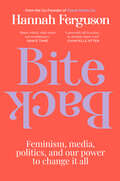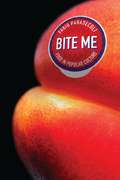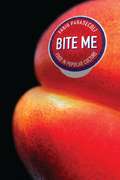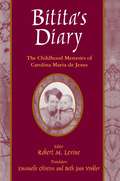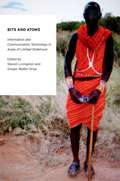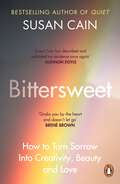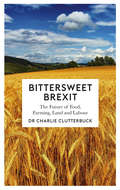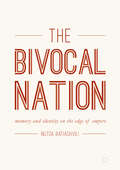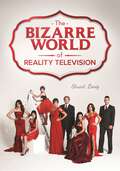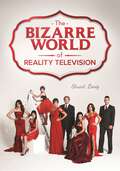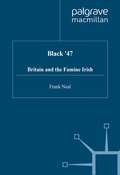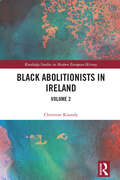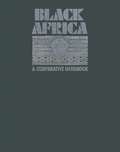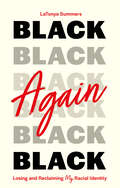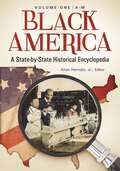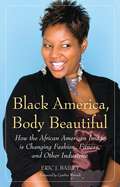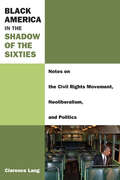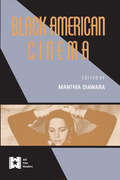- Table View
- List View
Bite Back: Feminism, media, politics, and our power to change it all
by Hannah FergusonThis is a book of opinions and ideas with bite. It's news that talks back.Founded in 2020, Cheek Media Co. quickly established itself as the go-to platform for daring feminist opinions on everything from right-wing politics to overcoming taboos around sex and pleasure. In Bite Back, Cheek co-founder Hannah Ferguson turns her sharp, progressive perspective on the issues that matter. Her bold ideas will provoke you to think, spark important conversations and inspire meaningful social change.'A sharp-witted, whip-smart gift to the stale national media landscape. This book will revolutionise the discourse and readers' souls simultaneously.' Grace Tame'Brace yourself for an engaging, heart-stirring read that challenges and inspires. It's a powerful call to action for a fairer world - an absolute must-read!' Chantelle Otten'Intersectional feminist cheek, underscored by incisive intellectual commentary. It's great. Read it!' Tarang Chawla'Hannah Ferguson doesn't take a backward step in flaying what underscores the inequality at the heart of our society while at the same time offering humour, heart and tangible solutions for fixing the mess we've left new generations. A searing, devastating and unflinching view of what's gone wrong - and most importantly, how we take back power.' Amy Remeikis
Bite Me: Food in Popular Culture
by Fabio ParasecoliFood is not only something we eat, it is something we use to define ourselves. Ingestion and incorporation are central to our connection with the world outside our bodies. Food's powerful social, economic, political and symbolic roles cannot be ignored - what we eat is a marker of power, cultural capital, class, ethnic and racial identity.Bite Me considers the ways in which popular culture reveals our relationship with food and our own bodies and how these have become an arena for political and ideological battles. Drawing on an extraordinary range of material - films, books, comics, songs, music videos, websites, slang, performances, advertising and mass-produced objects - Bite Me invites the reader to take a fresh look at today's products and practices to see how much food shapes our lives, perceptions and identities.
Bite Me: Food in Popular Culture
by Fabio ParasecoliFood is not only something we eat, it is something we use to define ourselves. Ingestion and incorporation are central to our connection with the world outside our bodies. Food's powerful social, economic, political and symbolic roles cannot be ignored - what we eat is a marker of power, cultural capital, class, ethnic and racial identity.Bite Me considers the ways in which popular culture reveals our relationship with food and our own bodies and how these have become an arena for political and ideological battles. Drawing on an extraordinary range of material - films, books, comics, songs, music videos, websites, slang, performances, advertising and mass-produced objects - Bite Me invites the reader to take a fresh look at today's products and practices to see how much food shapes our lives, perceptions and identities.
Bitita's Diary: The Autobiography of Carolina Maria de Jesus
by Robert M. Levine Carolina Maria De Jesus Beth Joan Vinkler Emanuelle OliveiraCarolina Maria de Jesus (1914-1977), nicknamed Bitita, was a destitute black Brazilian woman born in the rural interior who migrated to the industrial city of Sao Paulo. This is her autobiography, which includes details about her experiences of race relations and sexual intimidation.
Bitita's Diary: The Autobiography of Carolina Maria de Jesus (Latin American Realities Ser.)
by Robert M. Levine Carolina Maria De Jesus Beth Joan Vinkler Emanuelle OliveiraCarolina Maria de Jesus (1914-1977), nicknamed Bitita, was a destitute black Brazilian woman born in the rural interior who migrated to the industrial city of Sao Paulo. This is her autobiography, which includes details about her experiences of race relations and sexual intimidation.
Bits and Atoms: Information and Communication Technology in Areas of Limited Statehood (Oxford Studies in Digital Politics)
by Steven Livingston Gregor Walter-DropBits and Atoms explores the governance potential found in the explosive growth of digital information and communication technology in areas of limited statehood. Today, places with weak or altogether missing state institutions are tied internally and to the larger world by widely available digital technology. The chapters in the book explore questions of when and if the growth in digital technology can fill some of the governance vacuum created by the absence of an effective state. For example, mobile money could fill a gap in traditional banking or mobile phones could allow rural populations to pay for basic services and receive much needed advice and market pricing information. Yet, as potentially revolutionary as this technology can be to areas of limited statehood, it still faces limitations. Bits and Atoms is a thought-provoking look at the prospects for and limitations of digital technology to function in place of traditional state apparatuses.
Bits and Atoms: Information and Communication Technology in Areas of Limited Statehood (Oxford Studies in Digital Politics)
by Steven Livingston Gregor Walter-DropBits and Atoms explores the governance potential found in the explosive growth of digital information and communication technology in areas of limited statehood. Today, places with weak or altogether missing state institutions are tied internally and to the larger world by widely available digital technology. The chapters in the book explore questions of when and if the growth in digital technology can fill some of the governance vacuum created by the absence of an effective state. For example, mobile money could fill a gap in traditional banking or mobile phones could allow rural populations to pay for basic services and receive much needed advice and market pricing information. Yet, as potentially revolutionary as this technology can be to areas of limited statehood, it still faces limitations. Bits and Atoms is a thought-provoking look at the prospects for and limitations of digital technology to function in place of traditional state apparatuses.
Bittersweet: How Sorrow and Longing Make Us Whole
by Susan CainTHE #1 NEW YORK TIMES BESTSELLER -- FROM THE AUTHOR OF THE INTERNATIONAL BESTSELLER QUIET: THE POWER OF INTROVERTS IN A WORLD THAT CAN'T STOP TALKINGIn her inspiring new masterpiece, the author of the bestselling phenomenon Quiet describes her powerful quest to understand how love, loss and sorrow make us whole - revealing the power of a bittersweet outlook on life.Bittersweetness is a tendency towards states of longing, poignancy and sorrow; an acute awareness of passing time; and a curiously piercing joy at the beauty of the world. It recognizes that light and dark, birth and death - bitter and sweet - are forever paired.If you seek out beauty in your everyday life . . .If you find comfort or inspiration in a rainy day . . .If you react intensely to music, art and nature . . .Then you probably identify with the bittersweet state of mind.With Quiet, Susan Cain urged our society to cultivate space for the undervalued, indispensable introverts among us, thereby revealing an untapped power hidden in plain sight. Now she employs the same mix of research, storytellingand memoir to explore how embracing the bittersweetness at the heart of life is the true path to creativity and connection.Cain shows movingly how a bittersweet state of mind - though we've been blind to its value - is the quiet force that helps us transcend our personal and collective pain. It can change the way we live, the way we work and the way we love. If we realize that all humans know - or will know - loss and suffering, we can turn towards one another.At a time of profound discord and personal anxiety, Bittersweet brings us together in deep and unexpected ways.
Bittersweet Brexit: The Future of Food, Farming, Land and Labour
by Charlie Clutterbuck*Selected as one of openDemocracy's Best Political Books of 2017**BR**BR*Although widely criticised and hugely wasteful, The Common Agricultural Policy did at least afford British farmers a degree of support. Post-Brexit, that support will vanish - to be replaced with a woefully misconceived agricultural export drive that cannot possibly deliver. *BR**BR*Bittersweet Brexit suggests a solution: paying workers decent wages in the agricultural sector could radically transform the nature of farming in Britain. It would improve yields, increase sustainability and ensure greater self-sufficiency at a time when food security is becoming a vital issue. *BR**BR*This scenario provides a progressive, forward-thinking and optimistic future for food and farming in Britain, which, unlike many other industries, is currently being ignored.
Bittersweet Brexit: The Future of Food, Farming, Land and Labour
by Charlie Clutterbuck*Selected as one of openDemocracy's Best Political Books of 2017**BR**BR*Although widely criticised and hugely wasteful, The Common Agricultural Policy did at least afford British farmers a degree of support. Post-Brexit, that support will vanish - to be replaced with a woefully misconceived agricultural export drive that cannot possibly deliver. *BR**BR*Bittersweet Brexit suggests a solution: paying workers decent wages in the agricultural sector could radically transform the nature of farming in Britain. It would improve yields, increase sustainability and ensure greater self-sufficiency at a time when food security is becoming a vital issue. *BR**BR*This scenario provides a progressive, forward-thinking and optimistic future for food and farming in Britain, which, unlike many other industries, is currently being ignored.
The Bivocal Nation: Memory and Identity on the Edge of Empire
by Nutsa BatiashviliThis book is about a divided nation and polarized nationhood. Its principal purpose is to examine division and polarization as forms of imagining that are configured within culture and framed by history. This is what bivocality signifies—two distinct discursive voices through which nationhood is articulated; voices that are nonetheless grounded in a culturally common symbolic field. The volume offers an ethnographically centered analysis of the ways in which Georgians make use of these voices in critical discourses of nationhood. By illuminating the cultural semantics behind these discourses, Nutsa Batiashvili offers a new constellation of conceptual terms for understanding modern forms of nationalism and nation-building in the marginal or liminal landscapes between the Orient and the Occident.
The Bizarre World of Reality Television
by Stuart LenigHow do reality television programs shape our view of the world and what we perceive as real and normal? This book explores the bizarre and highly controversial world of reality television, including its early history, wide variety of subject matter, and social implications.In recent decades, reality television shows ranging from Keeping up with the Kardashians to Duck Dynasty have become increasingly popular. Why are these "unscripted" programs irresistible to millions of viewers? And what does the nearly universal success of reality shows say about American culture? This book covers more than 100 major and influential reality programs past and present, discussing the origins and past of reality programming, the contemporary social and economic conditions that led to the rise of reality shows, and the ways in which the most successful shows achieve popularity with both male and female demographics or appeal to specific, targeted niche audiences.The text addresses reality TV within five, easy-to-identify content categories: competition shows, relationship/love-interest shows, real people or alternative lifestyle and culture shows, transformation shows, and international programming. By examining modern reality television, a topic of great interest for a wide variety of readers, this book also discusses cultural and social norms in the United States, including materialism, unrealistic beauty ideals, gender roles and stereotypes in society, dynamics of personal relationships, teenage lifestyles and issues, and the branding of people for financial gain and wider viewership.
The Bizarre World of Reality Television
by Stuart LenigHow do reality television programs shape our view of the world and what we perceive as real and normal? This book explores the bizarre and highly controversial world of reality television, including its early history, wide variety of subject matter, and social implications.In recent decades, reality television shows ranging from Keeping up with the Kardashians to Duck Dynasty have become increasingly popular. Why are these "unscripted" programs irresistible to millions of viewers? And what does the nearly universal success of reality shows say about American culture? This book covers more than 100 major and influential reality programs past and present, discussing the origins and past of reality programming, the contemporary social and economic conditions that led to the rise of reality shows, and the ways in which the most successful shows achieve popularity with both male and female demographics or appeal to specific, targeted niche audiences.The text addresses reality TV within five, easy-to-identify content categories: competition shows, relationship/love-interest shows, real people or alternative lifestyle and culture shows, transformation shows, and international programming. By examining modern reality television, a topic of great interest for a wide variety of readers, this book also discusses cultural and social norms in the United States, including materialism, unrealistic beauty ideals, gender roles and stereotypes in society, dynamics of personal relationships, teenage lifestyles and issues, and the branding of people for financial gain and wider viewership.
Black 1919: Riots, Racism and Resistance in Imperial Britain (Postcolonialism Across the Disciplines #5)
by Jacqueline JenkinsonThe riots that broke out in various British port cities in 1919 were a dramatic manifestation of a wave of global unrest that affected Britain, parts of its empire, continental Europe and North America during and in the wake of the First World War. During the riots, crowds of white working-class people targeted black workers, their families and black-owned businesses and property. One of the chief sources of violent confrontation in the run-down port areas was the ‘colour’ bar implemented by the sailors’ trades unions campaigning to keep black, Arab and Asian sailors off British ships in a time of increasing job competition. Black 1919 sets out the economic and social causes of the riots and their impact on Britain’s relationship with its empire and its colonial subjects. The riots are also considered within the wider context of rioting elsewhere on the fringes of the Atlantic world as black people came in increased numbers into urban and metropolitan settings where they competed with working-class white people for jobs and housing during and after the First World War. The book details the events of the port riots in Britain, with chapters devoted to assessing the motivations and make-up of the rioting crowds, examining police procedures during the riots, considering the court cases that followed, and looking at the longer-term consequences for the black British workers and their families. Black 1919 is a stark and timely reminder of the violent racist conflict that emerged after the First World War and the shockwaves that reverberated around the Empire.
Black '47: Britain and the Famine Irish
by F. NealThe Irish Famine of 1845-49 was a major modern catastrophe. The return of the potato blight in 1846 triggered a huge exodus of destitute Irish seeking refuge in British towns and 1847 witnessed an unprecedented inflow of Irish refugees into Britain. This book examines the scale of that refugee immigration, the conditions under which the refugees were carried to Britain, the relief operations mounted, the horrors of the typhus epidemic in Liverpool, Glasgow, Manchester, South Wales and the North-East, and the financial cost to the British ratepayers.
Black Abolitionists in Ireland: Volume 2 (Routledge Studies in Modern European History)
by Christine KinealyBuilding on the narratives explored in volume one, this publication recovers the story of a further seven Black visitors to Ireland in the decades prior to the American Civil War.This volume examines each of these seven activists and artists, and how their unique and diverse talents contributed to the movement to abolish enslavement and to the demand for Black equality. In an era that witnessed the rise of minstrelsy, they provided a powerful counter argument to the lie of Black inferiority. Moreover, their interactions with Irish abolitionists helped to build a strong transatlantic movement that had a global reach and impact. The lives explored are: Ira Aldridge (the African Roscius), William Henry Lane (Master Juba), William P. Powell, Elizabeth Greenfield (the Black Swan), Reuben Nixon, James Watkins and William H. Day. Individually and collectively they demonstrated the agency and power of Black involvement in the search for social justice.This book will be of value to students and scholars alike interested in modern European history and social and cultural history.
Black Abolitionists in Ireland: Volume 2 (Routledge Studies in Modern European History)
by Christine KinealyBuilding on the narratives explored in volume one, this publication recovers the story of a further seven Black visitors to Ireland in the decades prior to the American Civil War.This volume examines each of these seven activists and artists, and how their unique and diverse talents contributed to the movement to abolish enslavement and to the demand for Black equality. In an era that witnessed the rise of minstrelsy, they provided a powerful counter argument to the lie of Black inferiority. Moreover, their interactions with Irish abolitionists helped to build a strong transatlantic movement that had a global reach and impact. The lives explored are: Ira Aldridge (the African Roscius), William Henry Lane (Master Juba), William P. Powell, Elizabeth Greenfield (the Black Swan), Reuben Nixon, James Watkins and William H. Day. Individually and collectively they demonstrated the agency and power of Black involvement in the search for social justice.This book will be of value to students and scholars alike interested in modern European history and social and cultural history.
Black Africa: A Comparative Handbook
by Robert C. Mitchell Donald G. Morrison John N. PadenBlack Africa presents political, economic and social data for 41 black African nations. The first edition was published in 1972 and included only data on 32 countries - which was the total number of independent African nations at that time. Enlarging on the first edition, this second edition covers in detail important aspects of the countries included, from demography to political development and social mobilization to a modern comparative analysis of African states. Black Africa is a complete and comprehensive handbook. The first edition of Black Africa won a Book of the Year Award from the American Library Association.
Black Again: Losing and Reclaiming My Racial Identity
by LaTonya Summers"I was driven by the belief that if I wanted to go somewhere I'd need to be something other than Black."LaTonya Summers was only six years old the first time she unconsciously tried to be "more white". Recollecting experiences from her childhood in foster care through to her life today as an Assistant Professor and mother, LaTonya examines how her perception of self was affected by internalized racism and led her to adopt white norms - influencing everything from her music and clothing choices to her speech and values. Join LaTonya in her journey of realization - how all those years assimilating, stretching and pressing for whiteness harmed her, and how, in a world that sees her as Black, it's about time she did too. Discover how LaTonya has truly "made it" by embracing and endorsing the Afrocentric norms and values that have sustained her and her family better than any white picket fence ever could.
Black Again: Losing and Reclaiming My Racial Identity
by LaTonya Summers"I was driven by the belief that if I wanted to go somewhere I'd need to be something other than Black."LaTonya Summers was only six years old the first time she unconsciously tried to be "more white". Recollecting experiences from her childhood in foster care through to her life today as an Assistant Professor and mother, LaTonya examines how her perception of self was affected by internalized racism and led her to adopt white norms - influencing everything from her music and clothing choices to her speech and values. Join LaTonya in her journey of realization - how all those years assimilating, stretching and pressing for whiteness harmed her, and how, in a world that sees her as Black, it's about time she did too. Discover how LaTonya has truly "made it" by embracing and endorsing the Afrocentric norms and values that have sustained her and her family better than any white picket fence ever could.
Black America [2 volumes]: A State-by-State Historical Encyclopedia [2 volumes]
This two-volume encyclopedia presents a state-by-state history of African Americans in the 50 states and the District of Columbia.African American populations are established in every area of the United States, including Hawaii and Alaska (more than10 percent of the population of Fairbanks, Alaska, is African American). Black Americans have played an invaluable role in creating our great nation in myriad ways, including their physical contributions and labor during the slavery era; intellectually, spiritually, and politically; in service to our country in military duty; and in areas of popular culture such as music, art, sports, and entertainment.The chapters extend chronologically from the colonial period to the present. Each chapter presents a timeline of African American history in the state, a historical overview, notable African Americans and their pioneering accomplishments, and state-specific traditions or activities. This state-by-state treatment of information allows readers to take pride in what happened in their state and in the famous people who came from their state.
Black America, Body Beautiful: How the African American Image is Changing Fashion, Fitness, and Other Industries (Non-ser.)
by Eric J. BaileyDespite all the medical and media attention focused on the rate of overweight and obesity in the African American population, African American images and body types are greatly influencing changes in the fashion, fitness, advertising, television and movie industries. This is because overweight, like beauty, can be in the eye of the beholder. Most research studies investigating attitudes about body image and body type among African Americans have shown they are more satisfied with their bodies than are their white counterparts and that there appears to be a wider range of acceptable body shapes and weights, and a more flexible standard of attractiveness, among black Americans as compared to whites. That fact is not being lost on leaders of industries that might profit from understanding this wider range of beauty, as well as playing to it. In this book, medical anthropologist Eric Bailey introduces and explains the self-acceptance and body image satisfaction of African Americans, and traces how that has spurred changes in industry. His book fills the void of scientific evidence to enhance the understanding of African Americans' perceptions related to body image and beauty—and is the first to document these issues from the perspective of an African American male.Despite all the medical and media attention focused on the rate of overweight and obesity in the African American population, African American images and body types are greatly influencing changes in the fashion, fitness, advertising, television, and movie industries. This is because overweight, like beauty, can be in the eye of the beholder. Most research studies investigating attitudes about body image and body type among African Americans have shown they are more satisfied with their bodies than are their white counterparts. Most black women, for example, are of course concerned with how they look, but do not judge themselves in terms of their weight and do not believe they are valued mostly on the basis of their bodies. Black teen girls most often say being thick and curvaceous with large hips and ample thighs is seen as the most desirable body shape. Thus, there appears to be a wider range of acceptable body shapes and weights, and a more flexible standard of attractiveness, among black Americans as compared to whites. That fact is not lost on leaders of industries that might profit from understanding this wider range of beauty, as well as playing to it. Voluptuous supermodel Tyra Banks is just one African American who's broken the mold in that industry. The effects have been seen right down to department and local clothes stores, where lines of larger and plus-size fashions are expanding, becoming more colorful and more ornate. In the fitness industry, health gurus Madonna Grimes and Billy Blanks have been revolutionizing how people get fit and how fitness needs to be redeveloped for the African American population. Advertising has taken a similar turn, not the least manifestation of which were the major campaigns Dove and Nike ran in 2005 with plus-sized actresses (who continue to appear in promotions for both companies). In movies and on television shows, the African American beautiful body image has followed suit.In this book, medical anthropologist Eric Bailey introduces and explains the self-acceptance and body image satisfaction of African Americans, and traces how that has spurred changes in industry. His book fills the void of scientific evidence to enhance the understanding of African Americans' perceptions related to body image and beauty—and is the first to document these issues from the perspective of an African American male.
Black America in the Shadow of the Sixties: Notes on the Civil Rights Movement, Neoliberalism, and Politics (Class : Culture)
by Clarence LangThe 1960s, including the black social movements of the period, are an obstacle to understanding the current conditions of African Americans, argues Clarence Lang. While Americans celebrate the current anniversaries of various black freedom milestones and the election of the first black president, the effects of neoliberalism since the 1970s have been particularly devastating to African Americans. Neoliberalism, which rejects social welfare protections in favor of individual liberty, unfettered markets, and a laissez-faire national state, has produced an environment in which people of color struggle with unstable employment, declining family income, rising household debt, increased class stratification, and heightened racial terrorism and imprisonment. The book argues that a reassessment of the Sixties and its legacies is necessary to make better sense of black community, leadership, politics, and the prospects for social change today. Combining interdisciplinary scholarship, political reportage, and personal reflection, this work sheds powerful light on the forces underlying the stark social and economic circumstances facing African Americans today, as well as the need for cautious optimism alongside sober analysis.
Black American Cinema
by Manthia DiawaraThis is the first major collection of criticism on Black American cinema. From the pioneering work of Oscar Micheaux and Wallace Thurman to the Hollywood success of Spike Lee, Black American filmmakers have played a remarkable role in the development of the American film, both independent and mainstream.In this volume, the work of early Black filmmakers is given serious attention for the first time. Individual essays consider what a Black film tradition might be, the relation between Black American filmmakers and filmmakers from the diaspora, the nature of Black film aesthetics, the artist's place within the community, and the representation of a Black imaginary. Black American Cinema also uncovers the construction of Black sexuality on screen, the role of Black women in independent cinema, and the specific question of Black female spectatorship. A lively and provocative group of essays debate the place and significance of Spike LeeOf crucial importance are the ways in which the essays analyze those Black directors who worked for Hollywood and whose films are simplistically dismissed as sell-outs, to the Hollywood "master narrative," as well as those "crossover" filmmakers whose achievements entail a surreptitious infiltration of the studios. Black American Cinema demonstrates the wealth of the Black contribution to American film and the complex course that contribution has taken.Contributors: Houston Baker, Jr., Toni Cade Bambara, Amiri Baraka, Jacquie Bobo, Richard Dyer, Jane Gaines, Henry Louis Gates, Jr., Ron Green, Ed Guerrero, bell hooks, Phyllis Klotman, Ntongele Masilela, Clyde Taylor, and Michele Wallace.
Black American Cinema
by Manthia DiawaraThis is the first major collection of criticism on Black American cinema. From the pioneering work of Oscar Micheaux and Wallace Thurman to the Hollywood success of Spike Lee, Black American filmmakers have played a remarkable role in the development of the American film, both independent and mainstream.In this volume, the work of early Black filmmakers is given serious attention for the first time. Individual essays consider what a Black film tradition might be, the relation between Black American filmmakers and filmmakers from the diaspora, the nature of Black film aesthetics, the artist's place within the community, and the representation of a Black imaginary. Black American Cinema also uncovers the construction of Black sexuality on screen, the role of Black women in independent cinema, and the specific question of Black female spectatorship. A lively and provocative group of essays debate the place and significance of Spike LeeOf crucial importance are the ways in which the essays analyze those Black directors who worked for Hollywood and whose films are simplistically dismissed as sell-outs, to the Hollywood "master narrative," as well as those "crossover" filmmakers whose achievements entail a surreptitious infiltration of the studios. Black American Cinema demonstrates the wealth of the Black contribution to American film and the complex course that contribution has taken.Contributors: Houston Baker, Jr., Toni Cade Bambara, Amiri Baraka, Jacquie Bobo, Richard Dyer, Jane Gaines, Henry Louis Gates, Jr., Ron Green, Ed Guerrero, bell hooks, Phyllis Klotman, Ntongele Masilela, Clyde Taylor, and Michele Wallace.
